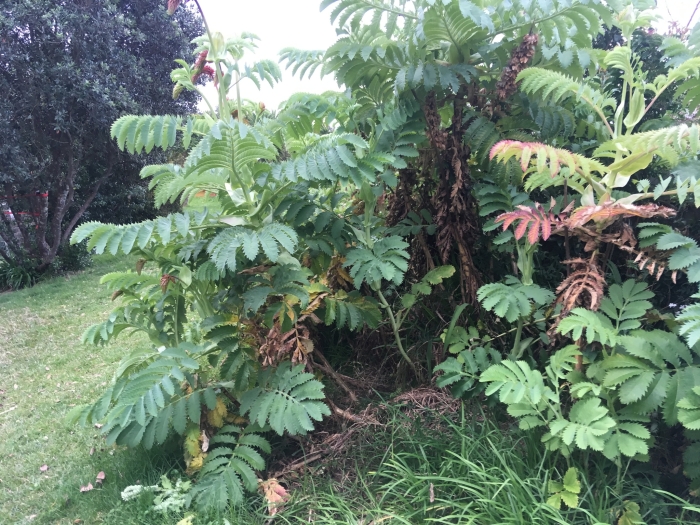Giant Honey-Flower
(Melianthus major)
Giant Honey-Flower (Melianthus major)
/
/

Jenny Christianson
CC BY 4.0
Image By:
Jenny Christianson
Recorded By:
Copyright:
CC BY 4.0
Copyright Notice:
Photo by: Jenny Christianson | License Type: CC BY 4.0 | License URL: http://creativecommons.org/licenses/by/4.0/ | Rights Holder: Jenny Christianson | Publisher: iNaturalist | Date Created: 2018-08-28T17:14:39-07:00 |

























































Estimated Native Range
Summary
Melianthus major, commonly known as Giant Honey-Flower, is an evergreen suckering perennial herb or shrub native to the Cape region, where it thrives in open woodlands and on stream banks. It can grow to 2–3 m (7–10 ft) tall by 1–3 m (3–10 ft) wide. The plant features striking pinnate blue-green leaves 30–50 cm (12–20 in) long, which emit a distinctive musky odor when crushed. In spring, it produces dark red, nectar-rich flower spikes, 30–80 cm (12–31 in) in length, which are highly attractive to birds and insects. The flowers are followed by green pods. All parts of the plant are poisonous if ingested.
Giant Honey-Flower is valued for its architectural foliage and dramatic flower spikes, making it a focal point in borders and exotic garden schemes. It prefers a sheltered position in full sun or partial shade and well-drained soil. In temperate regions, a protective winter mulch is recommended to protect the roots from cold. Regular watering is necessary, especially during dry periods. While it is not known for serious pest or disease problems, it can be susceptible to frost damage. In areas where it is not native, such as India, Australia, and New Zealand, it has naturalized and is considered potentially invasive. Gardeners should consult local regulations before planting and manage its spread to prevent escape into natural areas.CC BY-SA 4.0
Giant Honey-Flower is valued for its architectural foliage and dramatic flower spikes, making it a focal point in borders and exotic garden schemes. It prefers a sheltered position in full sun or partial shade and well-drained soil. In temperate regions, a protective winter mulch is recommended to protect the roots from cold. Regular watering is necessary, especially during dry periods. While it is not known for serious pest or disease problems, it can be susceptible to frost damage. In areas where it is not native, such as India, Australia, and New Zealand, it has naturalized and is considered potentially invasive. Gardeners should consult local regulations before planting and manage its spread to prevent escape into natural areas.CC BY-SA 4.0
Plant Description
- Plant Type: Shrub
- Height: 6-12 feet
- Width: 8-10 feet
- Growth Rate: Moderate
- Flower Color: Purple, Red
- Flowering Season: Winter, Spring
- Leaf Retention: Evergreen
Growth Requirements
- Sun: Full Sun, Part Shade
- Water: Medium
- Drainage: Slow, Medium, Fast
Common Uses
Bee Garden, Bird Garden, Butterfly Garden, Deer Resistant, Drought Tolerant, Hummingbird Garden, Potted Plant, Showy Flowers
Natural Habitat
Native to open woodlands and stream banks in the Cape region of South Africa
Other Names
Common Names: Tall Cape Honey-Flower, Cape Honeyflower, Honungsbuske
Scientific Names: , Melianthus major, Melianthus himalayanus,
GBIF Accepted Name: Melianthus major L.